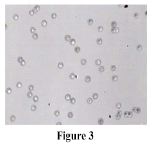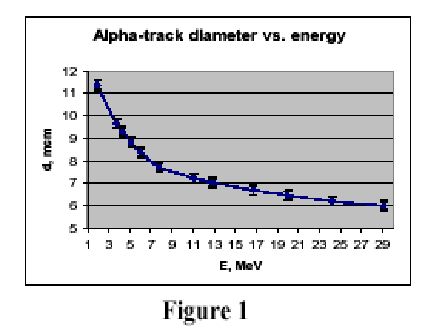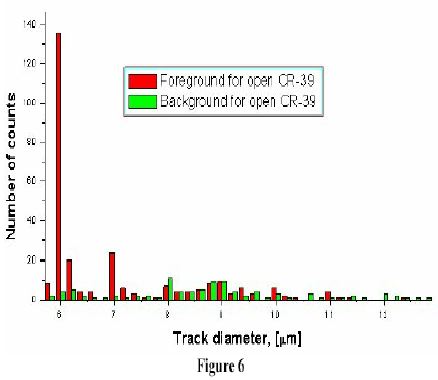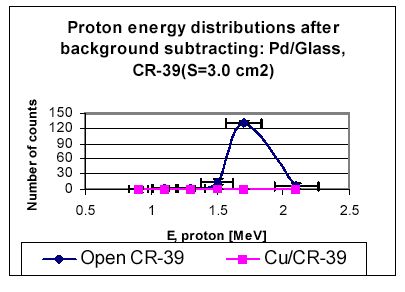Do you remember the article of A.B. Karabut which I translated in item # 13? He showed that generation of excess heat in a gas discharge tube (in which a Pd cathode was bombarded by ~ 1KeV D ions) was accompanied by emission of highly unusual alpha particles (14 MeV) and protons (3 MeV). Such particles were also observed in an electrochemical setup producing excess heat, as reported by A.G. Lipson et al. at the 9th International Conference on Cold Fusion (May, 2002, Beijing, China). The report can be downloaded from the library at the LENR-CANR site:
http://lenr-canr.org/Features.htm
Before summarizing the paper let me mention two prestigious laboratories with which the authors are affiliated. One lab is at the Department of Nuclear, Plasma and Radiological Engineering at the University of Illinois at Urbaba-Champaign and another is at Lebedev Physics Institute in Moscow. The authors refer to an earlier study (2001) in which alpha particles and protons were found to accompany generation of heat from the “Au/Pd/PdO:D(H) heterostructure.” Alpha particles with energies between 8 and 14 MeV were identified with a set Si detectors, after the Pd cathode was removed from the electrolyte. In this study, on the other hand, the emission of unusual nuclear particles was observed during the electrolytic loading. Use of Si detectors in the liquid electrolyte would be very difficult and a different method of detection was used to identify particles, and to estimate their energies.

Note:
Figures are numbered
as in the original paper.
That method is often used to detect alpha particles (energies below 8 MeV) emitted from radon and thoron, present in air, and from their descendants. A special plastic material, commercially available under the name of CR-39, is exposed to alpha particles and then etched in hot NaOH for several hours. After that procedure the plastic sheet is examined under the microscope. It turns out that places damaged by alpha particles become visibly pits, as shown in Figure 3 below. Thus, the number of intercepted particles can be determined by counting the number of pits per unit area. By using alpha particles with energies between 2 and 29 MeV the authors established a relation between the pit diameters and energies, as illustrated in Figure 1. A similar curve was obtained for protons with energies between 0.7 and 3 MeV. Beams of alpha particles and protons, used to calibrate the CR-39 detectors, were produced with accelerators in Dubna, Russia.

In the electrolysis experiments some sheets of CR-39 were in contact with the Pd cathode while others were kept away from the cathode to measure the background. As expected, background sheets revealed presence of a small number of alpha particles the radon and thoron series. Plastic sheets designed to detect protons were coated with Cu foils whose thickness was 25 microns. Such foils stop all alpha particles below 9 MeV but transmit protons above 2.3 MeV.

The results, for the CR-39 sheets which were not coated with copper, are shown in Figure 6. Red bars refer to sheets which were in contact with the cathode while green bars refer to sheets measuring the background. It is clear that in the area of small pits (high energy alpha particles and nearly all protons) the background is very small in comparison with the emission from the cathode. The mean energy of dominant alpha particles was close to 14 MeV while that of protons was close to 1.6 MeV. The estimated emission rates were about 7 (per m2 per second) for alpha particles and about twice as much for protons. The energy distribution of protons is shown in the next figure.

The authors conclude that the “observed effect of long-range alpha and proton emission cannot be described in terms of nor natural alpha-nuclides contamination in Pd neither the cosmic ray interactions with cathode.” I was really impressed; the study does confirm the reality of an unusual nuclear process. It made me think about the old Geiger-Nuttall rule (the inverse correlation between the energy and half-life, later explained in terms of quantum mechanical tunneling). I think that the above observations are sufficiently important to justify building a special Si detectors telescope with a thin window and using it instead of CR-39, in the liquid.
How do researchers who conducted this study differ from mainstream scientists? Would the DOE or NSF approve a research grant seeking to further investigate the unexplained phenomenon?